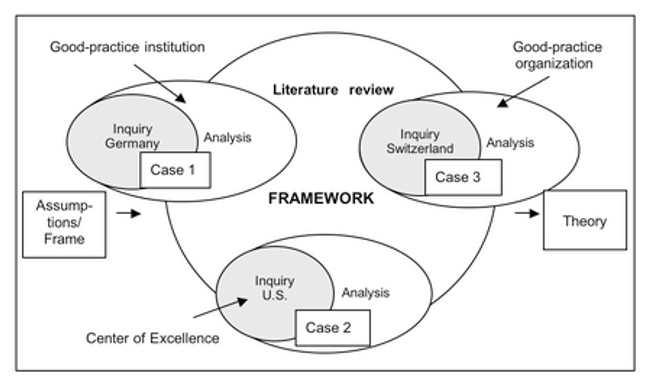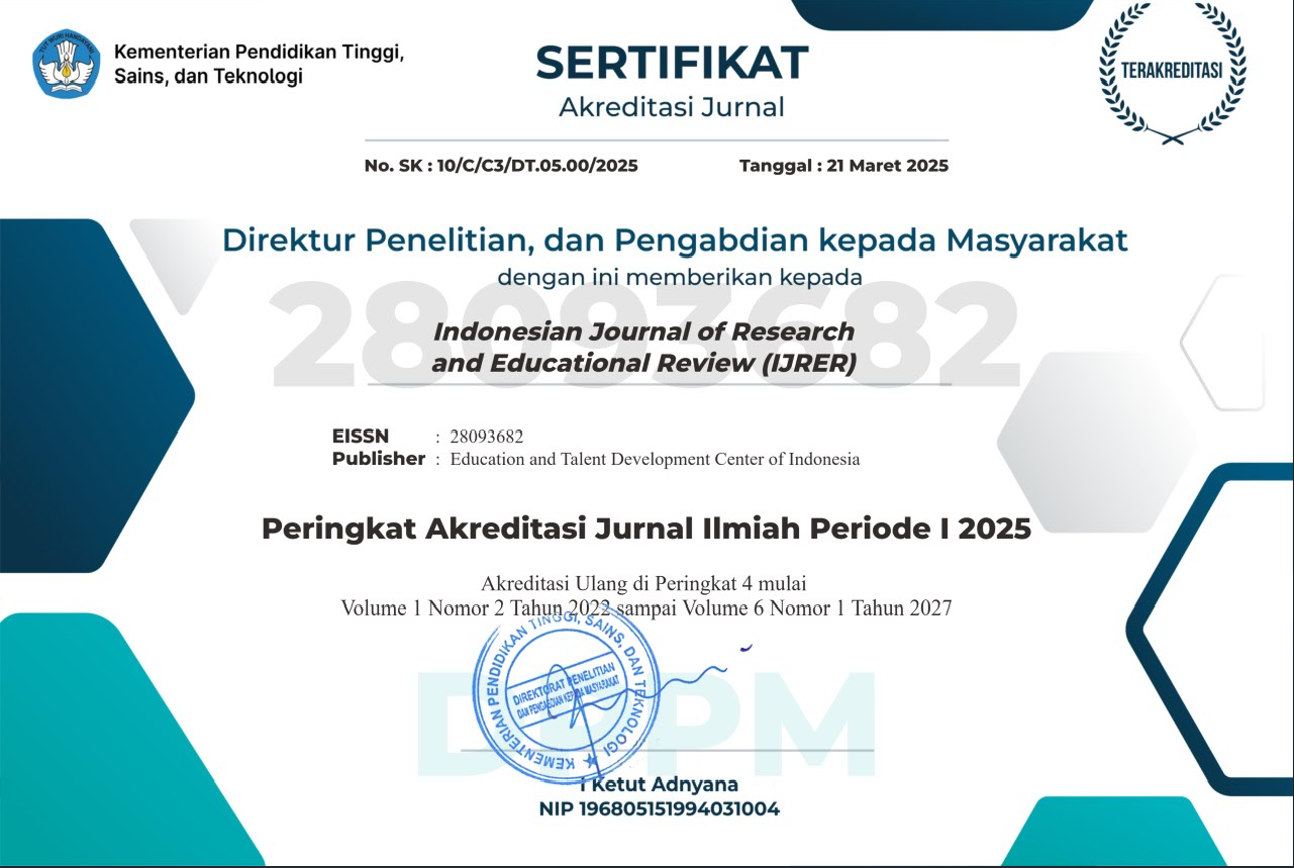Implementation of Green Therapy in Inclusive Education at Nature Schools
DOI:
https://doi.org/10.51574/ijrer.v4i4.3713Keywords:
Case Study, Green Therapy, Inclusive Education, Natural EnvironmentAbstract
This study explores the implementation of green therapy in the context of inclusive education and its impact on the well-being of students with special needs. The research method used is a qualitative case study in a nature school that implements green therapy as part of their inclusive approach. This research was conducted at Darul Istiqamah Maros Natural School. The study population consisted of students with special needs, teachers, school staff, and parents. The sampling technique used was purposive sampling, where three students with special needs were selected to participate in this study. Data collection was conducted through in-depth interviews with students, teachers, and parents; participant observation during Green Therapy activities; and document analysis related to the inclusion program and Green Therapy activities. The findings indicated that Green therapy in inclusive education positively impacts the physical, emotional, and social well-being of students with special needs, as shown by the study results. Students experienced improved social relationships with classmates, increased self-confidence, and engagement in learning. Green Therapy provided a meaningful and enjoyable learning experience for students, reflected in higher motivation and increased participation in school activities. Challenges in implementing green therapy include managing the natural environment, training teaching staff, and adapting activities to individual student needs. Collaboration between schools, parents, and experts is crucial for successful green therapy implementation in inclusive education. This study makes a valuable contribution to the development of more effective and sustainable inclusive education practices.
References
Astell-Burt, T., Mitchell, R., & Hartig, T. (2014). The association between green space and mental health varies across the lifecourse. A longitudinal study. Journal of Epidemiology and Community Health, 68(6), 578–583. https://doi.org/10.1136/jech-2013-203767
Berman, M. G., Jonides, J., & Kaplan, S. (2008). The Cognitive Benefits of Interacting with Nature. Psychological Science, 19(12), 1207–1212. https://doi.org/10.1111/j.1467-9280.2008.02225.x
Blumer, M. L., Hertlein, K. M., & Fife, S. T. (2012). It’s not easy becoming green: Student-therapist perceptions of family therapy in an eco-sustainable age. Contemporary Family Therapy, 34(1), 72-88.
Bratman, G. N., Anderson, C. B., Berman, M. G., Cochran, B., de Vries, S., Flanders, J., Folke, C., Frumkin, H., Gross, J. J., Hartig, T., Kahn Jr, P. H., Kuo, M., Lawler, J. J., Levin, P. S., Lindahl, T., Meyer-Lindenberg, A., Mitchell, R., Ouyang, Z., Roe, J., ... Daily, G. C. (2019). Nature and mental health: An ecosystem service perspective. Science Advances, 5(7), eaax0903. https://doi.org/10.1126/sciadv.aax0903
Danylchuk, L., Raievska, Y., Yurkiv, Y., Levitsky, V., Stynska, V., Krasnova, N., & Kravchyna, T. (2025). Sustainable Nature Therapy in Inclusive Educational Environments: Research Findings and Methodological Recommendations. European Journal of Sustainable Development, 14(1), 121-121.
El Zaatari, W., & Maalouf, I. (2022). How the Bronfenbrenner bio-ecological system theory explains the development of students’ sense of belonging to school?. Sage Open, 12(4), 21582440221134089.
Evans, W., Gable, R. A., & Habib, A. (2021). Lessons from the past and challenges for the future: Inclusive education for students with unique needs. Education Sciences, 11(6), 281. https://doi.org/10.3390/educsci11060281
Evans, P., Vansteenkiste, M., Parker, P., Kingsford-Smith, A., & Zhou, S. (2024). Cognitive load theory and its relationships with motivation: A self-determination theory perspective. Educational Psychology Review, 36(1), 7.
Florian, L. (2019). On the necessary co-existence of special and inclusive education. International journal of inclusive education, 23(7-8), 691-704. https://doi.org/10.1080/13603116.2019.1622801
Frumkin, H., Bratman, G. N., Breslow, S. J., Cochran, B., Kahn Jr, P. H., Lawler, J. J., Levin, P. S., Tandon, P. S., Varanasi, U., & Wolf, K. L. (2017). Nature Contact and Human Health: A Research Agenda. Environmental Health Perspectives, 125(7), 075001. https://doi.org/10.1289/EHP1663
Grenier, S., Gagné, M., & O'Neill, T. (2024). Self‐determination theory and its implications for team motivation. Applied Psychology, 73(4), 1833-1865.
Gunn, C., Vahdati, M., & Shahrestani, M. (2022). Green walls in schools-The potential well-being benefits. Building and Environment, 224, 109560. https://doi.org/10.1016/j.buildenv.2022.109560
Guy-Evans, O. (2020). Bronfenbrenner’s ecological systems theory. Simply Psychology, 10518-046.
Hajisoteriou, C., & Sorkos, G. (2023). Towards a new paradigm of “Sustainable Intercultural and inclusive education”: A comparative “blended” approach. Education Inquiry, 14(4), 496-512. https://doi.org/10.1080/20004508.2022.2071016
Hansen-Ketchum, P., & Marlowe, J. M. (2017). The Benefits of Nature-Based Play Therapy. Journal of Creativity in Mental Health, 12(4), 495–509. https://doi.org/10.1080/15401383.2017.1376452
Hartig, T., Evans, G. W., Jamner, L. D., Davis, D. S., & Gärling, T. (2003). Tracking restoration in natural and urban field settings. Journal of Environmental Psychology, 23(2), 109–123. https://doi.org/10.1016/S0272-4944(02)00109-3
Haryanti, D. (2020). Pengelolaan Kelas Inklusi Melalui Metode Belajar Bersama Alam (MBBA) di Sekolah Alam Bangka Belitung. Tarbawy : Jurnal Pendidikan Islam, 7(2), 128–136. https://doi.org/10.32923/tarbawy.v7i2.1464
Hayati, R. S., Syam, H., Husain, R., Studi, P., Biologi, P., Studi, P., Matematika, P., Makassar, U. M., Alam, S., & Istiqamah, D. (2023). Pusat Green Therapy Indonesia Timur Untuk. 2023, 409–423.
He, M., Hu, Y., Wen, Y., Wang, X., Wei, Y., Sheng, G., & Wang, G. (2024). The impacts of forest therapy on the physical and mental health of college students: a review. Forests, 15(4), 682.
Holt, E. W., Lombard, Q. K., Best, N., Smiley-Smith, S., & Quinn, J. E. (2019). Active and passive use of green space, health, and well-being amongst university students. International journal of environmental research and public health, 16(3), 424.
Jeronen, E., Palmberg, I., & Yli-Panula, E. (2016). Teaching methods in biology education and sustainability education including outdoor education for promoting sustainability—A literature review. Education Sciences, 7(1), 1.
Jung, W. H., Woo, J. M., & Ryu, J. S. (2015). Effect of a forest therapy program and the forest environment on female workers’ stress. Urban forestry & urban greening, 14(2), 274-281.
Kamran, M., Siddiqui, S., & Adil, M. S. (2023). Breaking barriers: The influence of teachers’ attitudes on inclusive education for students with mild learning disabilities (MLDs). Education Sciences, 13(6), 606. https://doi.org/10.3390/educsci13060606
Kwame Ameade, E. P., Owusuaa Amoah, L. A., & Ofori, B. Y. (2021). Green care as alternative therapy: The situation in Ghana. Evidence‐Based Complementary and Alternative Medicine, 2021(1), 8812379.
Korpela, K., & Ylén, M. (2007). Effectiveness of favorite-place prescriptions: A field experiment. American Journal of Preventive Medicine, 32(5), 391–397. https://doi.org/10.1016/j.amepre.2007.01.010
Krahenbuhl, K. S. (2016). Student-centered education and constructivism: Challenges, concerns, and clarity for teachers. The Clearing House: A Journal of Educational Strategies, Issues and Ideas, 89(3), 97-105.
Kuo, M. (2015). How might contact with nature promote human health? Promising mechanisms and a possible central pathway. Frontiers in Psychology, 6, 1093. https://doi.org/10.3389/fpsyg.2015.01093
Louv, R. (2008). Last Child in the Woods: Saving Our Children from Nature-Deficit Disorder. Algonquin Books.
Mayer, F. S., Frantz, C. M., Bruehlman-Senecal, E., & Dolliver, K. (2009). Why Is Nature Beneficial? The Role of Connectedness to Nature. Environment and Behavior, 41(5), 607–643. https://doi.org/10.1177/0013916508319745
McCormick, R. (2017). Does access to green space impact the mental well-being of children: A systematic review. Journal of pediatric nursing, 37, 3-7.
Nieuwenhuis, M., Knight, C., Postmes, T., & Haslam, S. A. (2014). The relative benefits of green versus lean office space: Three field experiments. Journal of Experimental Psychology: Applied, 20(3), 199–214. https://doi.org/10.1037/xap0000024
Ohly, H., White, M. P., Wheeler, B. W., Bethel, A., Ukoumunne, O. C., Nikolaou, V., Garside, R., & Jones, M. (2016). Attention Restoration Theory: A Systematic Review of the Attention Restoration Potential of Exposure to Natural Environments. Journal of Toxicology and Environmental Health - Part B: Critical Reviews, 19(7), 305–343. https://doi.org/10.1080/10937404.2016.1196155
Rumjaun, A., & Narod, F. (2025). Social learning theory—albert bandura. In Science education in theory and practice: An introductory guide to learning theory (pp. 65-82). Cham: Springer Nature Switzerland.
Rijal, M. S. (2025). Pendekatan Holistik untuk Meningkatkan Kualitas Pendidikan Siswa Inklusi di Sekolah Dasar. Journal of Education and Social Science, 1(2), 30-34.
Risty Justicia, Etha Salaza Titiana , Hana Fahranaz Fairuz, S. L. (2022). Implementasi Green Therapy Pada Anak Usia Dini Di Sekolah Alam Purwakarta. Edukids Volume 19 (1) Tahun 2022, 19(1), 62–69. https://doi.org/10.17509/edukids.v19i1.43989
Pretty, J., Peacock, J., Hine, R., Sellens, M., South, N., & Griffin, M. (2007). Green Exercise in the UK Countryside: Effects on Health and Psychological Well-being, and Implications for Policy and Planning. Journal of Environmental Planning and Management, 50(2), 211–231. https://doi.org/10.1080/09640560601156466
Roe, J. J., Thompson, C. W., Aspinall, P. A., Brewer, M. J., Duff, E. I., Miller, D., Mitchell, R., & Clow, A. (2013). Green Space and Stress: Evidence from Cortisol Measures in Deprived Urban Communities
Šouláková, B., Kasal, A., Butzer, B., & Winkler, P. (2019). Meta-review on the effectiveness of classroom-based psychological interventions aimed at improving student mental health and well-being, and preventing mental illness. The Journal of Primary Prevention, 40(3), 255-278.
Stigsdotter, U. K., & Grahn, P. (2002). What Makes a Garden a Healing Garden? Journal of Therapeutic Horticulture, 13(2), 60–69.
Taylor, A. F., Kuo, F. E., & Sullivan, W. C. (2002). Views of Nature and Self-Discipline: Evidence from Inner City Children. Journal of Environmental Psychology, 22(1–2), 49–63. https://doi.org/10.1006/jevp.2001.0241
Wells, N. M., & Evans, G. W. (2003). Nearby Nature: A Buffer of Life Stress among Rural Children. Environment and Behavior, 35(3), 311–330. https://doi.org/10.1177/0013916503035003001
Woodcock, S., Sharma, U., Subban, P., & Hitches, E. (2022). Teacher self-efficacy and inclusive education practices: Rethinking teachers’ engagement with inclusive practices. Teaching and teacher education, 117, 103802. https://doi.org/10.1016/j.tate.2022.103802

Downloads
Published
How to Cite
Issue
Section
License
Copyright (c) 2025 Anisah Aah Marfuah, Zulfikar Zulfikar

This work is licensed under a Creative Commons Attribution-ShareAlike 4.0 International License.









1.png)













